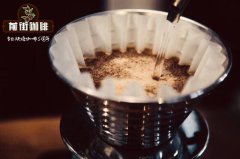Three major coffee bean treatment methods Coffee bean sun treatment is the most traditional and simple treatment.

Professional coffee knowledge exchange more coffee bean information please follow the coffee workshop (Wechat official account cafe_style)
Introduction to Qianjie-Coffee treatment
Sun treatment is the simplest and cheapest traditional method in coffee bean processing. During processing, the harvested fruit should be spread on the cement floor, brick floor or straw mat, dried in the sun, and often raked evenly to prevent fermentation. If it rains or the temperature drops, the fruit must be covered to prevent damage.
After about treatment, the water content of each fruit will drop to about 12%. At this time, the fruit is dry. In Brazil, coffee beans at this stage are called "cocoa". At this time, its skin is dark brown and fragile. Coffee beans can also be heard clucking in the shell.
In fact, this process requires a lot of technology, if the coffee beans are overdried, they are easy to be damaged when they are shelled, while coffee beans that are not sufficiently dried are also vulnerable to damage.
This method is commonly used in Ethiopia and Brazil, while most Arabica coffee beans are used.
Honey Process
Honey treatment method
Honey treatment is to pick out unripe beans and other defective bean leaves after flotation, and then carry out red, yellow and black treatment according to different areas.
Usually, yellow honey removes the most peel, about 40% of the peel, 25% of the peel of red honey, and only the peel of black honey, which is fermented to a certain extent and then dried by dryer or direct light.
Washed process
Washing method
Water treatment requires more money and energy, but it helps to ensure the quality of coffee beans and reduce damage.
The main difference between drying and water treatment is that during water treatment, the pulp is immediately separated from the coffee beans instead of drying them.
Water treatment is used to treat freshly picked coffee beans. The flesh of the coffee is stripped off as soon as possible, and the shorter the interval, the better. Then the coffee beans are soaked in water for 12-36 hours, a process in which the skin is softened so that it can be washed off easily. Coffee beans are then sorted and dried in the sun.
Knowledge: honey treatment is divided into three kinds: yellow honey, red honey and black honey.
In short: Qianjie is a coffee research hall, happy to share the knowledge about coffee with you, we share unreservedly just to make more friends fall in love with coffee, and there will be three low-discount coffee activities every month. The reason is that Qianjie wants to make more friends drink the best coffee at the lowest price, which has been Qianjie's tenet for 6 years!
END
Important Notice :
前街咖啡 FrontStreet Coffee has moved to new addredd:
FrontStreet Coffee Address: 315,Donghua East Road,GuangZhou
Tel:020 38364473
- Prev

Costa Rican coffee brand Mozart single coffee bean white wine taste and balanced acidity
Professional coffee knowledge exchange more coffee bean information please follow the coffee workshop (Wechat official account cafe_style) front street-Costa Rica Mozart introduction Costa Rica Mozart producing area: Tarrazu bean seed: Caturra altitude: 1700m classification standard: SHB treatment: raisin honey treatment soil: volcanic soil flavor description: orange blossom, lemon blossom, grape, orange
- Next

A brief introduction to three processing methods of coffee beans the characteristics of washing coffee beans highlight the original flavor
Professional coffee knowledge exchange more coffee bean information please pay attention to the coffee workshop (Wechat official account cafe_style) front street-Coffee treatment introduction tanning is the oldest method of treatment, according to literature, as early as 1000 years ago in the 11th century AD, the Arabs began to use the sun to treat coffee fruit. Because of the refreshing effect of coffee, coffee from Allah at that time
Related
- Beginners will see the "Coffee pull flower" guide!
- What is the difference between ice blog purified milk and ordinary milk coffee?
- Why is the Philippines the largest producer of crops in Liberia?
- For coffee extraction, should the fine powder be retained?
- How does extracted espresso fill pressed powder? How much strength does it take to press the powder?
- How to make jasmine cold extract coffee? Is the jasmine + latte good?
- Will this little toy really make the coffee taste better? How does Lily Drip affect coffee extraction?
- Will the action of slapping the filter cup also affect coffee extraction?
- What's the difference between powder-to-water ratio and powder-to-liquid ratio?
- What is the Ethiopian local species? What does it have to do with Heirloom native species?

